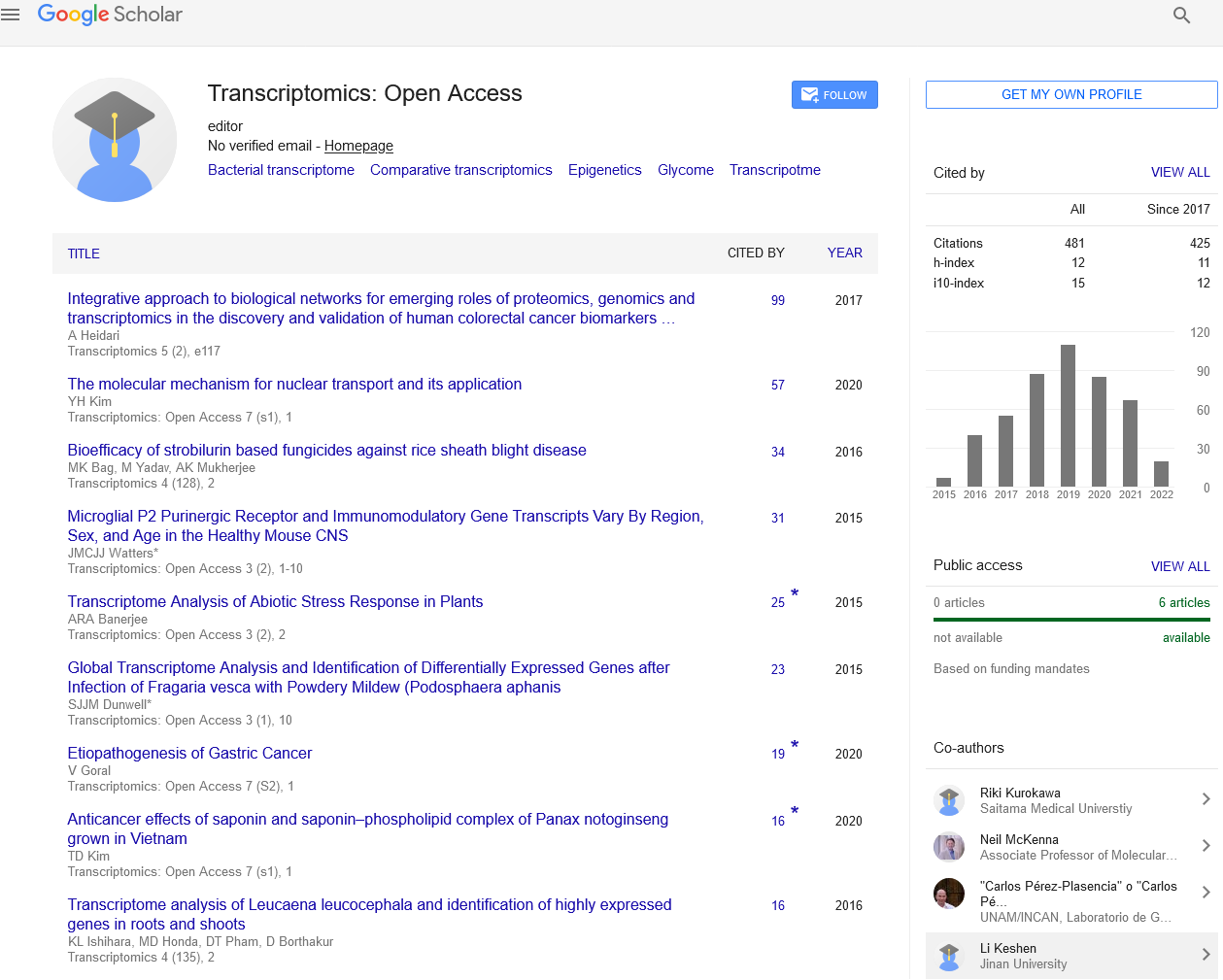Transcriptomics: Open Access : Citations & Metrics Report
Articles published in Transcriptomics: Open Access have been cited by esteemed scholars and scientists all around the world. Transcriptomics: Open Access has got h-index 13, which means every article in Transcriptomics: Open Access has got 13 average citations.
Following are the list of articles that have cited the articles published in Transcriptomics: Open Access.
| 2024 | 2023 | 2022 | 2021 | 2020 | 2019 | 2018 | 2017 | 2016 | 2015 | 2014 | 2013 | |
|---|---|---|---|---|---|---|---|---|---|---|---|---|
Total published articles |
30 | 32 | 30 | 25 | 24 | 0 | 2 | 4 | 14 | 28 | 6 | 6 |
Research, Review articles and Editorials |
0 | 2 | 1 | 10 | 5 | 0 | 1 | 1 | 9 | 17 | 5 | 6 |
Research communications, Review communications, Editorial communications, Case reports and Commentary |
14 | 40 | 30 | 16 | 8 | 0 | 1 | 2 | 5 | 11 | 1 | 0 |
Conference proceedings |
0 | 0 | 0 | 0 | 0 | 0 | 0 | 50 | 52 | 111 | 0 | 0 |
Citations received as per Google Scholar, other indexing platforms and portals |
42 | 58 | 67 | 78 | 96 | 113 | 96 | 67 | 57 | 6 | 2 | 3 |
| Journal total citations count | 552 |
| Journal impact factor | 2.08 |
| Journal 5 years impact factor | 4.98 |
| Journal cite score | 6.92 |
| Journal h-index | 13 |
| Journal h-index since 2019 | 11 |
Important citations (451)
Acoustic spectroscopy, acoustic resonance spectroscopy and auger spectroscopy comparative study on anti–cancer nano drugs delivery in malignant and benign human cancer cells and tissues with the passage of time under synchrotron radiation |
|
Nuclear resonant inelastic x–ray scattering spectroscopy (nrixss) and nuclear resonance vibrational spectroscopy (nrvs) comparative study on malignant and benign human cancer cells and tissues under synchrotron radiation |
|
Grazing-incidence small-angle neutron scattering (gisans) and grazing-incidence x-ray diffraction (gixd) comparative study on malignant and benign human cancer cells, tissues and tumors under synchrotron radiation |
|
A novel approach to reduce toxicities and to improve bioavailabilities of dna/rna of human cancer cells–containing cocaine (coke), lysergide (lysergic acid diethyl amide or lsd), ?9 – tetrahydrocannabinol (thc) [(–)–trans–??–tetrahydrocannabinol], theobromine (xantheose), caffeine, aspartame (apm) (nutrasweet) and zidovudine (zdv) [azidothymidine (azt)] as anti–cancer nano drugs by coassembly of dual anti–cancer nano drugs to inhibit dna/rna of human cancer cells drug resistance |
|
A novel approach to reduce toxicities and to improve bioavailabilities of dna/rna of human cancer cells–containing cocaine (coke), lysergide (lysergic acid diethyl amide or lsd), ?9 – tetrahydrocannabinol (thc) [(–)–trans–??–tetrahydrocannabinol], theobromine (xantheose), caffeine, aspartame (apm) (nutrasweet) and zidovudine (zdv) [azidothymidine (azt)] as anti–cancer nano drugs by coassembly of dual anti–cancer nano drugs to inhibit dna/rna of human cancer cells drug resistance |
|
Putrescine, cadaverine, spermine and spermidine – enhanced precatalyst preparation stabilization and initiation (eppsi) nano molecules |
|
Investigation of anti-cancer nano drugs’ effects’ trend on human pancreas cancer cells and tissues prevention, diagnosis and treatment process under synchrotron and x-ray radiations with the passage of time using mathematica |
|
Ultraviolet photoelectron spectroscopy (ups) and ultraviolet–visible (uv–vis) spectroscopy comparative study on malignant and benign human cancer cells and tissues with the passage of time under synchrotron radiation |
|
Incredible natural–abundance double–quantum transfer experiment (inadequate), nuclear overhauser effect spectroscopy (noesy) and rotating frame nuclear overhauser effect spectroscopy (roesy) comparative study on malignant and benign human cancer cells and tissues under synchrotron radiation |
|
Small-angle neutron scattering (sans) and wide-angle x-ray diffraction (waxd) comparative study on malignant and benign human cancer cells and tissues under synchrotron radiation |
|
Infrared photo dissociation spectroscopy and infrared correlation table spectroscopy comparative study on malignant and benign human cancer cells and tissues under synchrotron radiation with the passage of time |
|
Electron phenomenological spectroscopy |
|
Cavity ring-down spectroscopy (crds), circular dichroism spectroscopy, cold vapour atomic fluorescence spectroscopy and correlation spectroscopy comparative study on malignant and benign human cancer cells and tissues with the passage of time under synchrotron radiation |
|
modern approaches in designing ferritin, ferritin light chain, transferrin, beta–2 transferrin and bacterioferritin–based anti–cancer nano drugs encapsulating |
|
Vibrational decahertz (dahz), hectohertz (hhz), kilohertz (khz), megahertz (mhz), gigahertz (ghz), terahertz (thz), petahertz (phz), exahertz (ehz), zettahertz (zhz) and yottahertz (yhz) imaging and spectroscopy comparative study on malignant and benign human cancer cells and tissues under synchrotron radiation |
|
Vibrational decihertz (dhz), centihertz (chz), millihertz (mhz), microhertz (?hz), nanohertz (nhz), picohertz (phz), femtohertz (fhz), attohertz (ahz), zeptohertz (zhz) and yoctohertz (yhz) imaging and spectroscopy comparative study on malignant and benign human cancer cells and tissues under synchrotron radiation |
|
Neutron spin echo spectroscopy and spin noise spectroscopy comparative study onmalignant and benign human cancer cells and tissues with the passage of time undersynchrotron radiation |
|
Overview of the role of vitamins in reducing negative effect of decapeptyl (triptorelin acetate or pamoate salts) on prostate cancer cells and tissues in prostate cancer treatment process through transformation of malignant prostate tumors into benign prostate tumors under synchrotron radiation |
|
Molecular mechanics and quantum chemical study on sites of action of sanguinarine using vibrational spectroscopy based on molecular mechanics and quantum chemical calculations |
|
A modern comparative and comprehensive experimental biospectroscopic study on different types of infrared spectroscopy of malignant and benign human cancer cells and tissues with the passage of time under synchrotron radiation |
|
